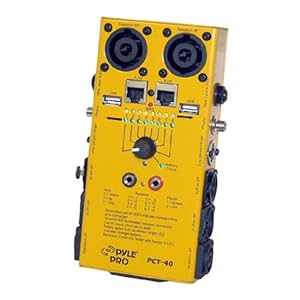Twisted pair cables such as Cat5, Cat5e, Cat6 and Cat6a cable are a low cost and easy facility alternative to original coax cables for transmitting Kvm and Av signals. Kvm (keyboard-video-mouse) extenders via Cat5 may be used to take off computers from harsh or sensitive environments, or to restrict corporal way to the computer. Video postponement products such as Vga, Dvi, S-Video or Hdtv extenders via Cat5 are used to increase video displays. Each extender consists of two units - the local and remote unit, which are interconnected using a Cat5/5e/6 cable.
This report focuses on the allowable formula for terminating a Cat6 shielded solid or stranded cable using suitable tools and materials that are readily available. With the allowable use of the tools and a petite practice you will be terminating Cat6 cables in no time.
Cable Tester
Prepare the cable
You will first need Cat6 shielded cable (solid or stranded for the purposes of this article) cut to the desired length. The cable can be concluded before or after installation, even if you have a long run to make. Using a cable tester from the cable can be nothing else but tested for continuity, crossed pairs and pinouts to make sure all connections have been made properly.
Next you will need to make sure you have the correct plugs to stop the cable with. Dissimilar plugs are intended to Dissimilar types of cable, whether you have solid or stranded connectors, flat or round cable, shielded or unshielded, and Cat5, 5e, 6, or 6a. Be sure to use a plug suitable for your cable.
For tools you need a Cat5 wire stripper, wire cutters, Rj45 crimp tool, and a Cat5 cable tester.
Terminate the cable
First, carefully strip the jacketing from the cable to expose 1" of the insulated wire conductors and shield. Don't cut too deeply or you will nick the shield and wire insulation underneath. If you just score the cable jacket and bend the wire in several directions to stop the break, the consequent will be a good problem-free cut.
Next, peel the foil shield insulation back onto the cable jacket and trim to within almost ¼" of the jacket edge. Wrap the drain wire such that it is located at the bottom (locking-tab side) of the cable. Do not take off any insulation from the conductors.
Trim the + shaped divider (an insulator core within some manufacturer's Cat6 cables, so this may or may not be present) that separates each of the twisted pair all the way back to the cut edge of the jacket.
Next, untwist the wires all the way to the jacket edge (but not beyond) and arrange them agreeing to Tia/Eia 568A or 568B standards.
For Cat6 cable, the Rj45 plug includes a loading bar used to properly space the wires for insertion into the Rj45 plug. Flatten and insert the wires into the loading bar. The loading bar has openings in it, one for each conductor. The wires must be located in the allowable order for whether the Tia/Eia 568A or 568B standard.
With the wires in the allowable order, slide the loading bar (with the raised edge up) all the way onto the cable as far as possible. Then trim off the excess wires that increase from the loading bar.
Insert the ready cable into the Rj45 plug such that the loading bar is fully inserted and the cable jacket extends inside the plug. The jacket and shield should increase at least 1/4" into the plug for allowable strain relief and shield connection. Make sure the drain wire is positioned at the bottom of the connector as this is where it will see the most perceive with the shield of the Rj45 plug.
Using the Rj45 crimp tool, crimp the assembled termination to make it permanent. Firmly squeeze the handles to set the contacts and collect the plug. Once crimped, the termination should be tight and very difficult to reMove.
Test the cable
Use the Cat5 cable tester to check your work. The tester will indicate allowable continuity (complete connection end-to-end), make sure the pairs have been matched up properly, and that the pinout is agreeing to the premium wire standard. If an end is wired incorrectly, the tester will indicate which end is incorrect. Plainly cut off the end and try again.
Be sure to see more articles about Cat5 cable termination. Other types of cable wish sLightly Dissimilar procedures, so not all of the details for the cable you want to stop will be covered in this article.
Assembly of a kind 6 Shielded Solid Or Stranded Rj45 PlugSee Also : USB Battery Charger & Accessories Deals Infant Car Seat Bose Professional Audio System Crawl Space Dehumidifiers


No comments:
Post a Comment